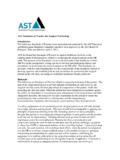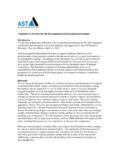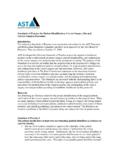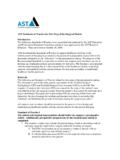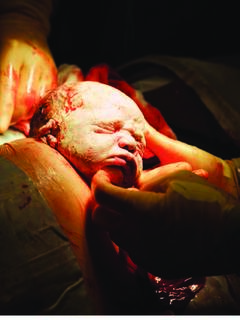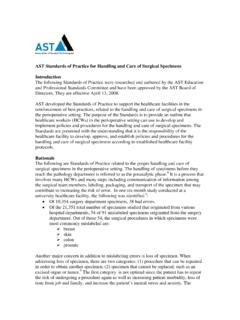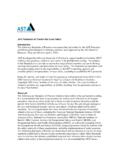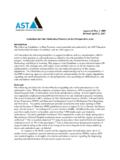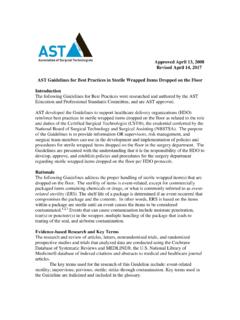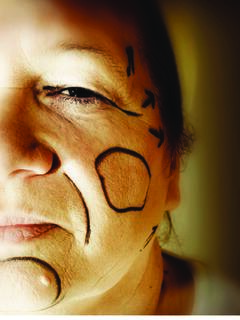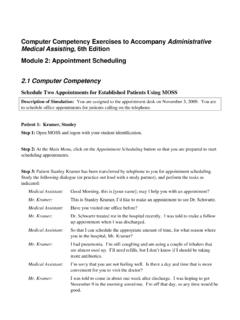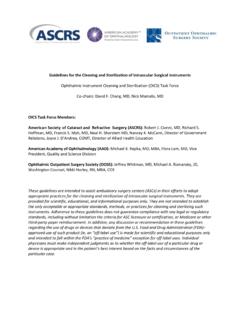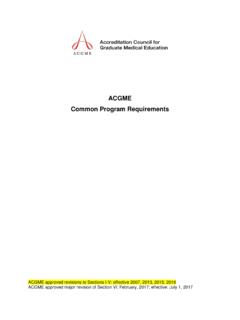Transcription of Standard Surgical Drapes - Association of Surgical ...
1 AST standards of Practice for Surgical Drapes Introduction The standards of Practice were researched and authored by the AST Education and Professional standards Committee and have been approved by the AST Board of Directors. They are effective April 13, 2008. AST developed the standards of Practice to support healthcare facilities in the reinforcement of best practices related to Surgical Drapes . The purpose of the recommended standards is to provide an outline that Surgical team members can use to develop and implement policies and procedures for Surgical Drapes . The standards is presented with the understanding that it is the responsibility of the healthcare facility to develop, approve, and establish policies and procedures for Surgical Drapes according to established healthcare facility protocols. Rationale The following are standards of Practice related to Surgical Drapes .
2 The primary purpose of draping the Surgical patient is to isolate the Surgical site from the other areas of the patient s body and nonsterile areas of the OR table in order to contribute to reducing the risk of Surgical site infection (SSI). The Drapes serve as a barrier to endogenous and exogenous sources of contamination, in particular endogenous contamination (patient s skin flora as the source), which is identified as a major source of Draping not only contributes to protecting the Surgical site, but expands the sterile field allowing the Certified Surgical Technologist (CST) and other members of the sterile Surgical team to place sterile instrumentation and supplies on the Drapes , eg establishing the neutral zone for passing sharps. Draping is performed on a routine basis in the care of Surgical patients and therefore, the standards of Practice address factors such as, choice of Drapes , desired drape characteristics, single-use versus reusable and general draping guidelines.
3 All Surgical team members should be involved in the process of developing and implementing healthcare facility policies and procedures as related to Drapes . Standard of Practice I Only sterile Drapes should be used within the sterile field. 1. Drapes create a barrier between the Surgical field and possible sources of microbes. Microbial migration and contamination from nonsterile to sterile areas is minimized by isolating the incision site and creating a sterile field with the use of sterile Drapes . 2. Drapes protect the patient from their own skin flora (endogenous source of contamination) and Surgical team members and environment (exogenous sources of contamination). 3. Drapes must be properly sterilized in accordance with the recommendations of American National standards Institute (ANSI) and the Association for the Advancement of Medical Instrumentation (AAMI).
4 A. Methods of sterilization for Drapes include, but are not limited to, radiation, steam, and ethylene oxide. 4. Sterile Surgical team members must not come into contact with the contaminated undersurface of the drape that has come into contact with a nonsterile surface. 5. Once a drape has been positioned, it should not be repositioned. The top of furniture, such as the OR table, back table and prep table are considered sterile, and the portion of the drape hanging below the edge is considered nonsterile. Repositioning can bring the nonsterile portion of the drape into the sterile field, causing contamination, as well as possibly transferring microbes onto the field, placing the patient at risk for acquiring an SSI. 6. Drapes should be handled as little as possible by the sterile team members. 7. When handling Drapes prior to placement on the patient, they should not be allowed to unfold.
5 8. The CST, Certified Surgical First Assistant (CSFA) and surgeon should maintain 12 away from the OR table when performing the draping procedure to avoid contamination of the sterile gloves and front of the gown. 9. The CST, CFA and surgeon should not reach across an undraped OR table in order to perform a draping procedure. A. When handing the four towels to the surgeon or CSFA to initially square off the incision site, the CST should stand on the same side of the OR table. 10. When draping the patient, the CST, CSFA and surgeon should protect the sterile, gloved hands from contamination by cuffing the hands. 11. Nonperforating towel clips should be used to keep towels or Drapes in place. 12. When reusable woven Drapes are used, manufacturer s instructions should be consulted in regard to the care and reprocessing of the Drapes . 13. Disposable and nondisposable contaminated Drapes should be properly contained at the end of the Surgical procedure.
6 The Drapes should be placed in impervious bags that are identified by the biohazard symbol. Standard of Practice II A compromise in the integrity of the microbial barrier results in contamination. 1. Drapes must be free of holes, punctures, and tears. A. Drapes should be resistant to punctures and tears to prevent microbial contamination of the sterile Standard of Practice III Drapes should be resistant to fluid penetration. 1. Intraoperatively patient body fluids and irrigating solutions come into contact with the Drapes . A. Draping material should be impervious and fluid-resistant to prevent strike-through contamination from Prevention of strike-through contamination reduces the risk of SSI. B. Blood, body fluids, and irrigating solutions should be suctioned and/or sponged as soon as possible from the drape in order to aid in preventing strike-through contamination.
7 C. Impervious barriers incorporated into Drapes , in particular around the fenestration, aid in providing additional protection in isolating the Surgical site and increase the resistance to strike-through D. It is recommended that the CST, when preparing the sterile back table and Mayo stand, not place the Drapes underneath the basin. If irrigation solution is poured into the basin by the circulator prior to draping the patient, fluid may spill out onto the Drapes , rendering them useless because of strike-through contamination. Increased costs may result due to the need for a replacement with a new sterile drape. Standard of Practice IV Drapes should be lint free. 1. Lint is recognized as a vector for causing SSI. Additionally, airborne lint serves as a medium for transport of microbes. A. Lint free Drapes minimize airborne contamination and spreading of particles into the Surgical wound.
8 Standard of Practice V Drapes should be flame resistant. 1. Currently, there are no local, state or federal regulations that establish standards of performance for Surgical Drapes . However, the majority of manufacturers of Drapes have adopted the same standards for Drapes as Surgical gowns. A. The standards that the Surgical team follow for guidance in evaluating Drapes , include the following: National Fire Protection Agency (NFPA): NFPA No. 702-1980 Standard for Classification of the Flammability of Wearing Apparel. In 1987, the NFPA removed this from their list of current standards , but it is still used as a reference by manufacturers, FDA, and AAMI as one of the standards to be used for evaluating the safety and performance characteristics of Drapes and gowns. This Standard established four classes for rating gowns by two factors: ignition and flame spread.
9 These four classes are also used for the evaluation of Drapes . Class 1, relatively slow burn, is the most relevant for Surgical team members. Consumer Product Safety Commission (CPSC): 16 CFR Part 1610, Standard for the Flammability of Clothing Textiles. Through this Standard , the CPSC is responsible for the regulation of Drapes and gowns. When evaluating a drape, the Surgical team members should confirm that the manufacturer s information includes the statement The Basic Fabric Meets the Class 1 Flammability Requirements for CPSC 16 CFR Part 2. Drapes should resist ignition from sources such as lasers, fiberoptics, and electrosurgery within the sterile field. 3. Healthcare facilities should establish policies and procedures for fire prevention. A. Fires involving Drapes can cause serious injuries to the patient and Surgical team members; therefore, all Surgical team members should be properly educated in fire prevention and healthcare facility protocol.
10 B. All HCWs should complete annual competencies on fire safety. Standard of Practice VI The Surgical team members should evaluate Drapes based upon the following factors and characteristics. 1. The draping material should be easy to handle and flexible in order to conform as much as possible to the contour of the patient and OR table. 2. The Drapes , in particular Drapes composed of reusable woven material, should be free of toxic substances, such as dyes and laundry detergent residues. 3. The draping material should have limited memory. 4. When evaluating Drapes , the Surgical team members should evaluate the information provided by the American Society for Testing and Materials (ASTM). A. ASTM developed the two tests, F1670 and F1671 for assessing the fluid and microbial barriers of Surgical nonwoven and woven fabrics. B. The manufacturer should provide the information, related to the results of these tests when the Surgical team members are evaluating Drapes .
